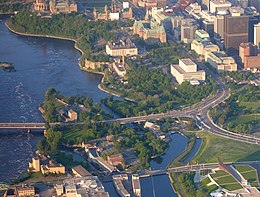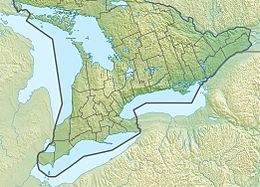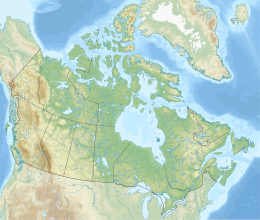Victoria Island[4] (French: Île Victoria, Algonquin: Asinabka)[5] is an island in the Ottawa River, located north of LeBreton Flats, 1 km west of Parliament Hill in Ottawa, Ontario. The island is "a place of special significance" to the local Algonquian peoples,[2] who use the island for ceremonial purposes and for protests.[6] It is part of an archipelago of islands below Chaudière Falls, which also includes the former Philemon Island, Chaudière Island, Amelia Island and Albert Island.[7]
Native name: Asinabka | |
|---|---|
 | |
| Geography | |
| Location | Ottawa River |
| Coordinates | 45°25′15″N 75°42′46″W / 45.42083°N 75.71278°W[1] |
| Area | 5.6 ha (14 acres)[2] |
| Length | 724 m (2375 ft) |
| Width | 205 m (673 ft) |
| Highest elevation | 54 m (177 ft)[3] |
| Highest point | Booth Street |
| Administration | |
Canada | |
| Province | Ontario |
| Census Division | Ottawa |
| Ward | Somerset Ward |
Both the Portage Bridge and Chaudière Bridge cross the island, connecting Ottawa to Gatineau, Quebec on the other side of the river. Otherwise, public access to the island is currently restricted due to an environmental remediation project set to be completed in 2025.[2] The project is projected to cost $13 million.[8]
History
editIndigenous people inhabited the area up to 9,000 years ago, using the island to portage and for trade. The nearby Chaudière Falls were used for ceremonial purposes,[2] meetings, and as a burial site.[5] The island was named for Queen Victoria and,[9] beginning in the 19th century, became the location of residences, commerce, and mixed industry,[2] including a sawmill, ironwork, and manufacturing companies.[8] The Wilson Carbide Mill, a four storey stone building named for Thomas Willson, the inventor of the process to produce calcium carbide and acetylene gas, was built on the island in 1900 to manufacture calcium carbide.[10][11] It has since been recognized as a Federal Heritage Building.[10]
Industrial use of the island contaminated the land, resulting in the current clean up operation. Soil samples taken in 2017 revealed that the island's soil, groundwater, and surface water were contaminated with ashes, lead, zinc, and fuel oil.[8] The National Capital Commission acquired most of the island in the 1960s and the remainder from Public Services and Procurement Canada in 2018.[2]
Protests
editThe island has a long history of Indigenous protests. In 1974, a group of protesters known as "The Native People's Caravan" occupied the Carbide Mill,[12] while in 1995 Aboriginal Defence League protesters broke into the mill and set up an "Aboriginal Embassy".[13] In 1988, Algonquins of Barriere Lake set up tents on the island to protest "the ravaging of their land by the federal and Quebec governments".[14] They returned in 1990, partly in solidarity of the Mohawk people in the Oka Crisis.[15] In 2013, Attawapiskat First Nation chief Theresa Spence took up residence on the island to protest against the Government of Canada.[5]
Future
editFollowing the completion of the remediation project, the NCC plans to work with the Algonquin Anishinaabe Nation to develop a master plan for the island and to re-open it to the public.[2]
See also
editReferences
edit- ^ "Victoria Island (Ottawa River)". Geographical Names Data Base. Natural Resources Canada.
- ^ a b c d e f g "Site Remediation at Victoria Island". National Capital Commission.
- ^ Ontario Base Survey
- ^ "Victoria Island". Geographical Names Data Base. Natural Resources Canada.
- ^ a b c "NCC treats Spence camp as case of self-expression". Ottawa Citizen. January 10, 2013. Retrieved 2021-07-01.
- ^ "Closing of Victoria Island in Ottawa catches some off guard". APTN.
- ^ "A Glimpse of Chaudière Falls". Ottawa Citizen. April 30, 2015. Retrieved 2021-07-11.
- ^ a b c "NCC closing Victoria Island for 7 years to clean up contaminated soil". Global News.
- ^ Ottawa Public Law Tour: Track 5 Ottawa River Islands, University of Ottawa, retrieved 14 August 2023
- ^ a b "Willson Carbide Mill". Canada's Historic Places.
- ^ "Cold-busting flower may also clean polluted soil". Ottawa Citizen. January 24, 2014. Retrieved 2021-07-01.
- ^ "Indians hold building". Ottawa Citizen. September 30, 1974. Retrieved 2021-07-01.
- ^ "Aboriginal Embassy". Ottawa Citizen. March 20, 1995. Retrieved 2021-07-01.
- ^ "Natives occupy island to protest land use". Ottawa Citizen. September 20, 1988. Retrieved 2021-07-01.
- ^ "Camping Out". Ottawa Citizen. July 26, 1990. Retrieved 2021-07-01.

